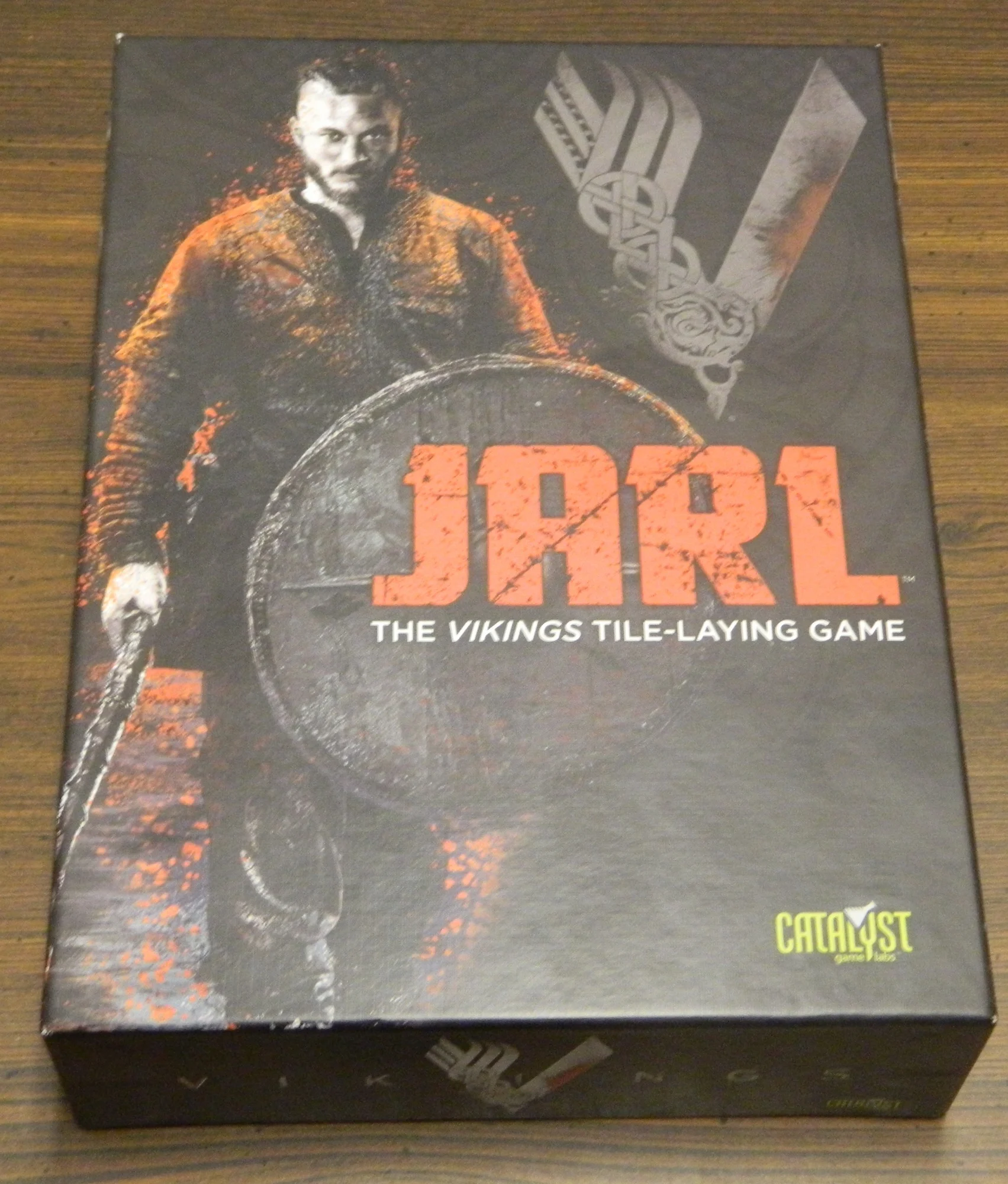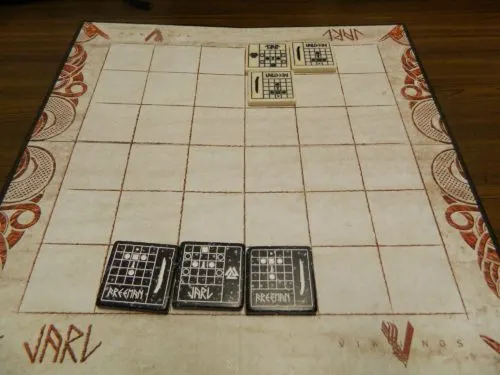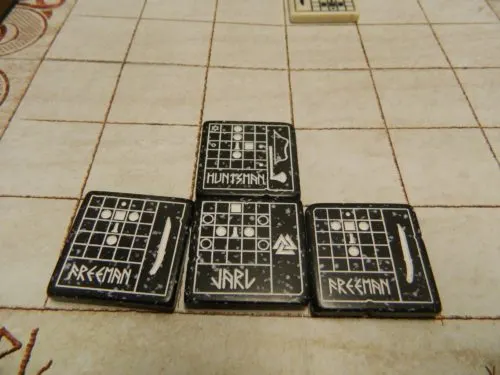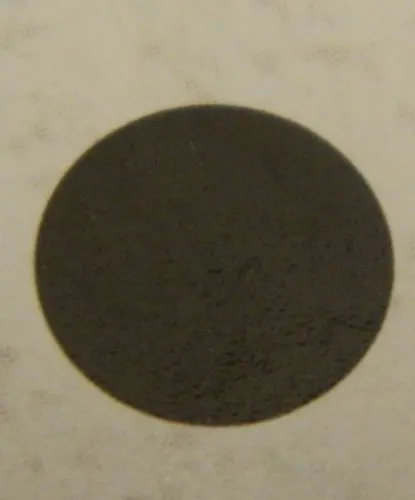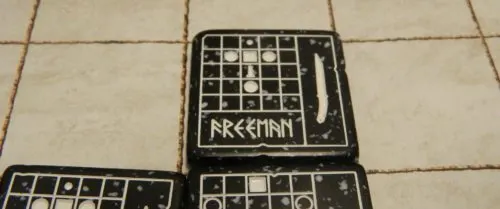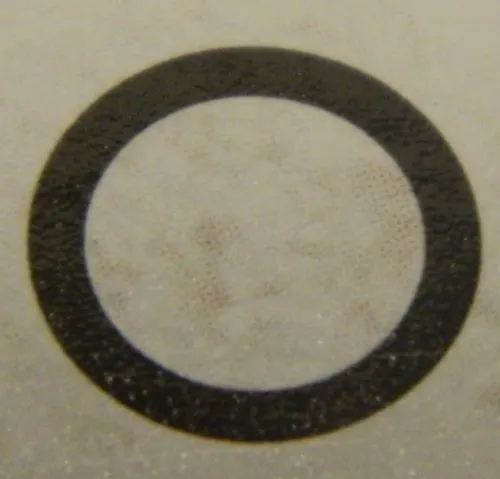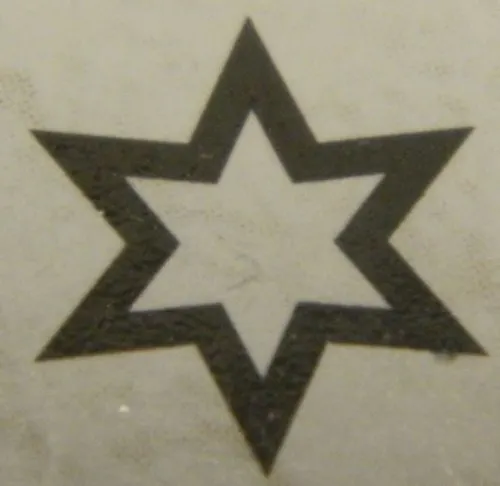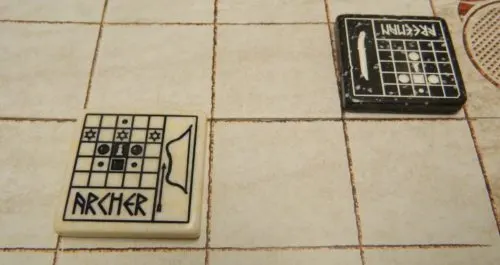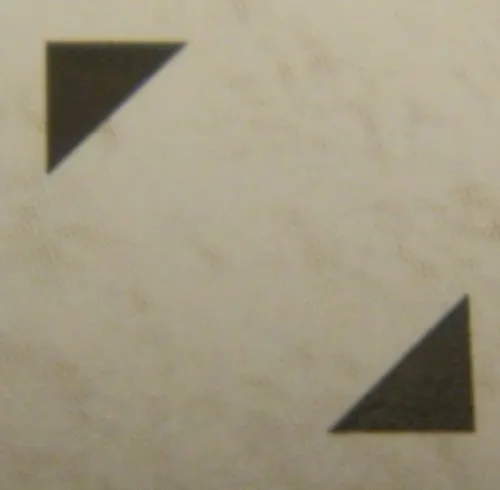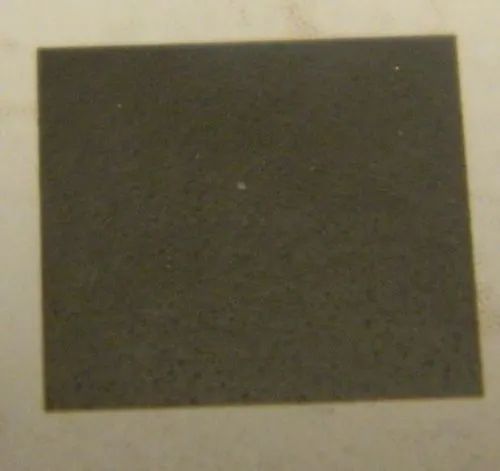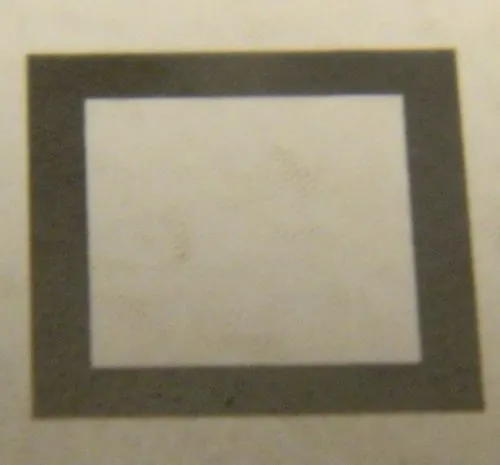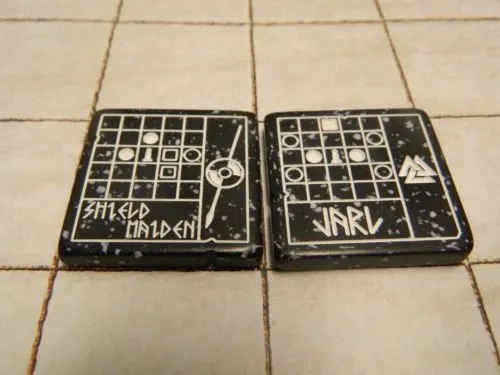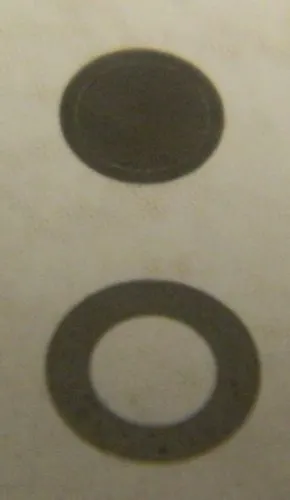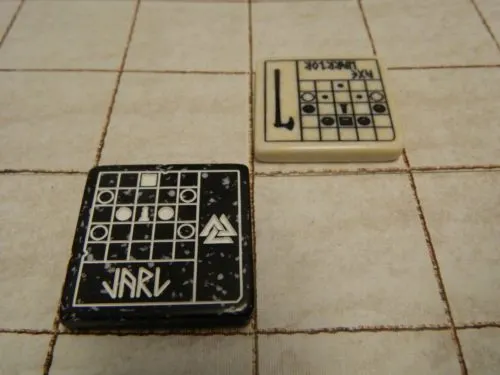What would you get if you took the classic game of Chess and decided to change things up? Instead of each piece having one defined move, every piece could perform quite a few different actions. This is exactly what The Duke did by taking Chess and expanding on the formula. The Duke has become a very popular abstract game which has lead to quite a few expansion packs. Today’s game Jarl: The Vikings Tile-Laying Game is another game in The Duke line of games which takes the mechanics and adds a Vikings theme to them. Having never played The Duke I was interested in seeing what Jarl: The Vikings Tile-Laying Game would play like. While the game suffers from some analysis paralysis issues, Jarl: The Vikings Tile-Laying Game adds some tweaks to Chess which lead to an interesting experience.
How to Play Jarl: The Vikings Tile-Laying Game
Setup
Place the gameboard in the center of the table. Each player takes one bag of warrior tiles and removes their Jarl and two Freeman tiles from their bag. Each player will place their Jarl on one of the middle two spaces on their side of the board in the first row. The two Freeman tiles will be placed on two of the spaces adjacent to the Jarl piece. The tiles must be placed with the starting side face up and the name of the piece facing the owner of the piece. Whichever player places their pieces first will get to start the game.
Playing the Game
On a player’s turn they will will perform one of two actions.
- Pull a random tile from your bag of tiles and place it on an unoccupied space adjacent to your Jarl piece. When placing a tile it is placed with the starting side face up (if there is no starting side you can choose a side). The piece’s text is orientated so the owner of the piece can read the text.
- Move one of your warrior tiles using one of the legal moves printed on the tile. Once you move the tile, flip it to the other side.
The player has to perform one of the two actions. If they are unable to perform one of the actions, they must perform the other action.
Moving Warriors
When looking at how you can move a warrior you will first look for the pawn symbol on the tile. This symbol represents the current position of the piece. The other symbols on the grid show the different actions that the warrior can perform and on what spaces relative to their current position that they can perform them. When moving a warrior you can only use one of the symbols. After moving the warrior you will flip it to the other side.
Move: The large filled in circle indicates a space that the warrior can move to. When moving the warrior they will take the most straightforward path between the warrior’s current position and the space they are moving to. If there are any warriors in the path between the current location and the location you are moving the piece to, you cannot use that move action. If one of your warriors are on the end location, you also can’t use that move action. If there is an enemy on the end location, you will capture that enemy tile.
Jump: The large unfilled circle indicates a space that a warrior can jump to. The jump action works the same as the move action except that there can be warriors on the spaces between the current location and the target space. If one of your warriors are on the target space, you can’t use the jump action. If there is an enemy on the target space, you will capture the enemy warrior.
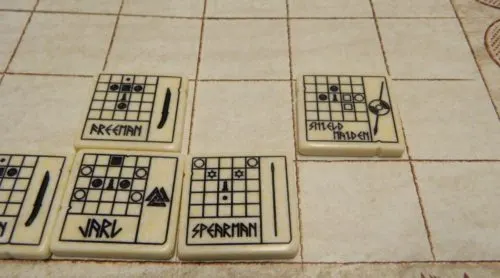
Using the jump icon the Spearman can jump diagonally over the Shield Maiden or Freeman to the next space.
Strike: The strike symbol allows a warrior to attack a space without moving. If an enemy warrior is on a strike space, the warrior can capture the enemy tile. When using the strike action the warrior tile is flipped over but is not moved from its’ current location.
Command: Using a command action allows a warrior to move another friendly tile to another space. A warrior that is on one of the spaces with the command action can be moved to another space that has the command action. The tile that is moved can move through other tiles to its’ destination but can’t be moved onto a space that has a friendly warrior. If the warrior is moved onto a space containing an enemy warrior, it captures that warrior. The warrior that used the command action will be flipped over instead of the warrior that was moved.

The Warlord has a command icon for the space that the Archer is currently on. The Warlord can use the command action to move the Archer to another space that has a command icon.
Dread: Any warrior that is on a space corresponding to a dread symbol cannot be moved, captured, shifted by a command ability, or use any of their actions. This effect stays in place until the beginning of the player’s turn that controls the warrior with the dread symbols. The Jarl tile and any tile with a dread symbol on it are unaffected by the effect of dread.
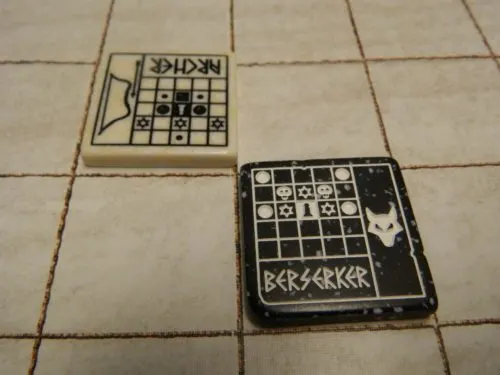
In this picture the black Berserker uses its’ dread symbol to prevent the Archer from taking any actions.
Defense: If a warrior has a defense symbol, no one can attack the warrior if they would have to move through the defense symbol. If a player is attacking with a jump or strike and there is no straight path to the target space, the player can use a path that moves around the defense symbol to capture the warrior. Using a command action allows a player to capture a tile while ignoring a defense symbol.
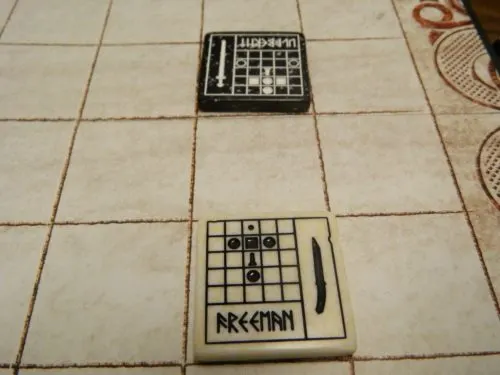
Normally the black piece would be able to attack the white piece. The white piece has a block symbol in the path of the black piece though which will block the attack.
Shield Defense: The shield defense symbols works similar to a defense symbol but it applies to warriors in the spaces indicated by the symbols. This ability acts like there is a defense symbol in every space around a warrior that is covered by a shield defense icon. The warrior that has the shield defense symbols on it is not protected by the symbols.
Non-Capture Move/Jump: These spaces follow the same rules as normal move and jump spaces but they do not allow you to capture a warrior on the target space.
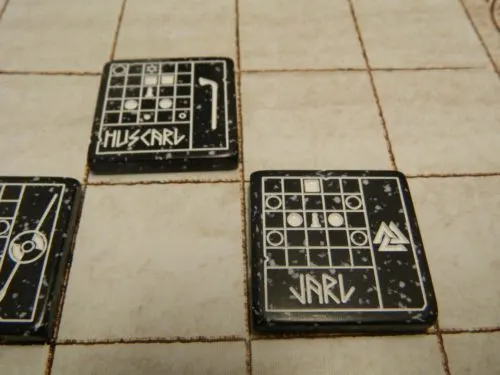
The Huscarl piece has a non-capture move and jump symbol which allows them to move behind the Jarl piece.
When a player captures a warrior, the warrior is removed from the board and is out of the game. If a player ever moves a warrior to a space that could capture the opponent’s Jarl on the next turn, they must tell the other player “guard”. While moving warriors you are unable to move a warrior that would then allow the other player to capture your Jarl on their next turn. Players are always allowed to look at the other side of their own tiles but can’t look at the back of their opponent’s tiles unless both players agree to allow it before the game begins.
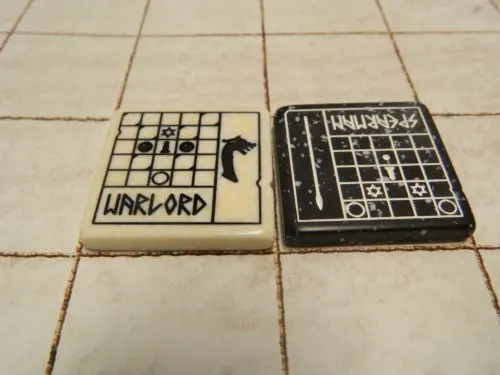
The Warlord has a move icon that lets them move to the right. By using that action they will land on the Spearman and capture it.
Winning the Game
A player can win the game in two ways.
- They capture the other player’s Jarl.
- The other player is unable to move or place any tiles on their turn.
My Thoughts on Jarl: The Vikings Tile-Laying Game
With Jarl: The Vikings Tile-Laying Game basically being a spin-off of The Duke, it should not come as much of a surprise that the game shares a lot in common with The Duke. The two games are so similar that the rules for Jarl even include some suggestions of how to combine the game with the tiles from The Duke. The main mechanics of the two games are exactly the same. The only real difference is that there are some slight differences in the actions that you can perform in both games. According to Board Game Geek this mostly leads to Jarl being more of a defensive game than The Duke. The two games are similar enough though that if you have played The Duke before you should already have a pretty good idea of whether you will enjoy Jarl: The Vikings Tile-Laying Game.
For those of you who have never played The Duke, I would classify Jarl: The Vikings Tile-Laying Game/The Duke as the next evolution of Chess. The influence of Chess is quite obvious since both games have the objective of capturing the other player’s King/Duke/Jarl. To do so you use pieces that have different move sets to capture the other player’s pieces and eventually their King. The one area where the two games differ is how the pieces move. In Chess each piece has a set movement pattern that never changes. In Jarl/The Duke each piece has quite a few different actions that it can perform and after each move the tile is flipped over which presents you with different options.
While it took a little while to get a hand of this mechanic in Jarl: The Vikings Tile-Laying Game, once you get a hang of it you really start to appreciate it. The different moves that each piece can make really adds quite a bit of strategy to Jarl: The Vikings Tile-Laying Game. With so many different options you have many different ways to approach every turn. I could see it taking hundreds of games, like Chess, to truly master Jarl/The Duke. People who like the challenge of Chess will probably love the strategic possibilities in Jarl/The Duke.
Jarl: The Vikings Tile-Laying Game is the perfect example of an abstract strategy game. Although it has a light Vikings theme, based on the History Channel show, Jarl is not a game that you play for the theme. You play Jarl for the game’s strategy just like with Chess. The Vikings theme is so light that you could easily apply any other theme and it wouldn’t change the game.
When you first look at Jarl: The Vikings Tile-Laying Game it may look kind of complicated. Each tile has so many symbols on it that it can be feel kind of overwhelming. It may look complicated but it is actually not that bad. Once you familiarize yourself with all of the different symbols in the game, the game is not that hard to play. While children probably won’t be able to play the game, I don’t see Jarl being much more complicated than Chess.
I will say that the box is misleading with regards to the length though. Jarl: The Vikings Tile-Laying Game has an estimated playtime of 15-25 minutes. I only see it not taking considerably longer under three circumstances. First if one of the players is able to quickly capture the other player’s Jarl. Second if both players play the game very casually and don’t spend a lot of time on their moves. Finally both players already know what every piece does so they don’t have to spend much time analyzing the grids on the tiles. Outside of these three situations I see Jarl taking at least 30 minutes to over an hour.
This disparity in length can mostly be attributed to a serious analysis paralysis problem in the game. I will admit that I like to take my time analyzing potential moves but the analysis paralysis is almost overwhelming in a game like Jarl: The Vikings Tile-Laying Game. The reason that the analysis paralysis is so bad is that there are so many options in the game. There will be some turns where you don’t have many options but on most turns you will have quite a few pieces to look at with each having several actions that you can take. This can easily lead to option overload. Unless you are playing with people that don’t have to analyze every different option, this can lead to a lot of waiting for the other player to make their move.
Another thing that adds to the length of the game is the fact that all of the pieces are double sided. I kind of like and don’t like the double sided tiles. I don’t like that the double sided tiles add quite a bit of time to the game. Unless you have memorized every tile you are going to spend quite a bit of time looking at the other sides of your tiles before you make a move. It is beneficial to look at the other side since you can then see the potential moves for the piece after it is moved. The double sided tiles also add quite a bit of luck to the game. Unless you know what actions are on both sides of the tile you don’t know what to expect out of your opponent’s tiles. Until you are familiar with the pieces you basically have to guess what is on the other side of any particular tile. If you guess wrong you could easily lose quite a few pieces that you otherwise could have protected.
I do like that the double sided tiles add a lot of strategy to the game. Since the possible actions for your warrior will always be changing you need to really think through future moves before moving a piece. On some of the pieces one side seems stronger than the other so once you use the strong side you will be stuck with the weaker side until you move it again. When moving your warriors you need to be sure not to put them in a vulnerable position based on what is on the other side of the tile. If you don’t consider future moves you could end up losing a piece that could have helped you win the game.
While Jarl: The Vikings Tile-Laying Game can really suffer from analysis paralysis, I see it as a game that will move quite a bit quicker once you have played the game to the point where you know what all of the pieces can do. Just like with Chess, Jarl seems like a game that is pretty easy to learn but takes a long time to master. The biggest hurdle to mastering the game is getting a good handle on what all of the different pieces in the game can do and how best to use them. Unlike Chess which only has six different movement patterns, there is probably at least 50 movement patterns in Jarl: The Vikings Tile-Laying Game. These will take quite a while to learn and thus in your early games you will be constantly referencing the grids on all of the tiles.
Even though familiarity with the game should shorten it, I think you still should consider implementing a time limit on how long a player can take on a turn. I think Jarl: The Vikings Tile-Laying Game is probably best as a 20-40 minute game. Once the game goes past 40 minutes it starts to drag. Without the time limit it will be really hard to get players that have to analyze every move to make their move in a considerate length of time. This leads to a lot of sitting around waiting for the other player to make their turn which can be a little boring.
Another small problem that I had with Jarl: The Vikings Tile-Laying Game is that some of the pieces seem a little too powerful. It makes total sense that some pieces are more powerful than others (the same can be said about Chess) but some just seem to be way too powerful. If you can get some pieces in the right position they can dominate the board. For example in one game that I played the other player was able to block off over half of the board with one piece. In order to move any of my pieces I had to move them up one side of the board or I had to sacrifice one of them to try and get the other player to flip over that warrior. The more you play the game the more likely you can avoid a situation like this but without a mastery of the game some of the pieces can feel kind of rigged.
My final issue with Jarl: The Vikings Tile-Laying Game is that it has a little too much reliance on luck. While there is not a ton of luck in the game, for this type of game there really shouldn’t be much luck at all. Chess for instance has basically no luck at all. Jarl relies on luck by giving an advantage to the player that draws the right tiles at the right times. The player who draws the stronger tiles earlier in the game will have an advantage in the game. A better player is likely to overcome the luck but in a game with two equally matched players luck could be the deciding factor in the game.
As far as the components are concerned there are a lot of things that I like along with a few things that I don’t really like. As a whole I really liked the tiles. The tiles are thick and look quite nice. The symbols might look a little simplistic but are pretty easy to understand after playing the game for a while. The only problem that I had with the tiles is that the “Command” symbols are really hard to see on the tiles. While the tiles are really nice, the gameboard felt kind of cheap. There is nothing particularly wrong with it but it just doesn’t live up to the quality of the tiles. Finally I can’t say that I am a fan of the instructions as I think they could have done a better job explaining some of the game’s mechanics.
Should You Buy Jarl: The Vikings Tile-Laying Game?
Jarl: The Vikings Tile-Laying Game along with The Duke are a really interesting take on Chess. While the two games share a lot in common with Chess, they give you so many more options. There is a lot of potential strategy in Jarl as every piece has its’ own unique movement pattern. You have so many options to make in the game that I could see it taking hundreds of games to master. This does lead to problems for the game though as there are so many options which can lead to some significant analysis paralysis problems. A game that should take 20-40 minutes can easily take over an hour. Some of the pieces also seem to be a little overpowered and there is a little too high of reliance on luck. These issues don’t ruin the game but they prevent it from being as good as it could have been.
If abstract strategy games like Chess aren’t your type of game, Jarl: The Vikings Tile-Laying Game is not going to be for you. If you like Chess though and can work through the analysis paralysis issues I think you will love Jarl: The Vikings Tile-Laying Game.
If you would like to purchase Jarl: The Vikings Tile-Laying Game you can find it online: Amazon, eBay

